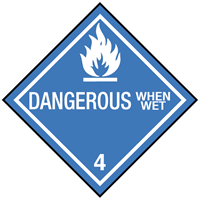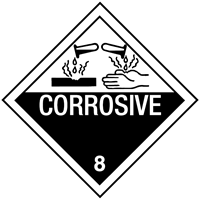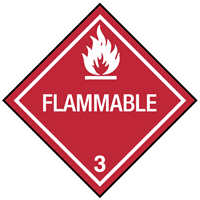Chemical Datasheet
METHYLDICHLOROSILANE |



|
Chemical Identifiers
The
Chemical Identifier fields
include common identification numbers, the
NFPA diamond
U.S. Department of Transportation hazard labels, and a general
description of the chemical. The information in CAMEO Chemicals comes
from a variety of
data sources.
| CAS Number | UN/NA Number | DOT Hazard Label | USCG CHRIS Code |
|---|---|---|---|
|
|
||
| NIOSH Pocket Guide | International Chem Safety Card | ||
| none | |||
NFPA 704
| Diamond | Hazard | Value | Description | |||||||||
|---|---|---|---|---|---|---|---|---|---|---|---|---|
|
|
4 | Can be lethal. | |||||||||
|
|
3 | Can be ignited under almost all ambient temperature conditions. | ||||||||||
|
|
2 | Readily undergoes violent chemical changes at elevated temperatures and pressures. | ||||||||||
|
|
Reacts violently or explosively with water. |
(NFPA, 2010)
General Description
A colorless fuming liquid with a pungent odor. Flash point: -26°F; Boiling point: 41°C (106°F). Vapors heavier than air. Vapor and liquid may cause burns. Denser than water and decomposed by water to form hydrochloric acid, a corrosive material.
Hazards
The
Hazard fields
include
special hazard alerts
air and water
reactions, fire hazards, health hazards, a reactivity profile, and
details about
reactive groups assignments
and
potentially incompatible absorbents.
The information in CAMEO Chemicals comes from a variety of
data sources.
Reactivity Alerts
- Highly Flammable
- Water-Reactive
- Pyrophoric
Air & Water Reactions
Highly flammable. May enflame spontaneously in air [NFPA 1991]. Undergoes vigorous reaction with water to generate hydrogen chloride, heat and other products. The heat may be sufficient to ignite nearby combustible material.
Methyldichlorosilane reacts vigorously with water to generate gaseous HCl. Based on a scenario where the chemical is spilled into an excess of water (at least 5 fold excess of water), half of the maximum theoretical yield of Hydrogen Chloride gas will be created in 0.12 minutes. Experimental details are in the following: "Development of the Table of Initial Isolation and Protective Distances for the 2008 Emergency Response Guidebook", ANL/DIS-09-2, D.F. Brown, H.M. Hartmann, W.A. Freeman, and W.D. Haney, Argonne National Laboratory, Argonne, Illinois, June 2009.
Methyldichlorosilane reacts vigorously with water to generate gaseous HCl. Based on a scenario where the chemical is spilled into an excess of water (at least 5 fold excess of water), half of the maximum theoretical yield of Hydrogen Chloride gas will be created in 0.12 minutes. Experimental details are in the following: "Development of the Table of Initial Isolation and Protective Distances for the 2008 Emergency Response Guidebook", ANL/DIS-09-2, D.F. Brown, H.M. Hartmann, W.A. Freeman, and W.D. Haney, Argonne National Laboratory, Argonne, Illinois, June 2009.
Fire Hazard
Special Hazards of Combustion Products: Toxic hydrogen chloride and phosgene gases may be formed.
Behavior in Fire: Difficult to extinguish; re-ignition may occur. Contact with water applied to adjacent fires will generate irritating hydrogen chloride gas. (USCG, 1999)
Behavior in Fire: Difficult to extinguish; re-ignition may occur. Contact with water applied to adjacent fires will generate irritating hydrogen chloride gas. (USCG, 1999)
Health Hazard
Inhalation causes irritation of respiratory tract; heavy exposure can cause pulmonary edema. Contact of liquid with skin or eyes causes severe burns. Ingestion causes burns of mouth and stomach. (USCG, 1999)
Reactivity Profile
Chlorosilanes, such as METHYLDICHLOROSILANE, are compounds in which silicon is bonded to from one to four chlorine atoms with other bonds to hydrogen and/or alkyl groups. Chlorosilanes react with water, moist air, or steam to produce heat and toxic, corrosive fumes of hydrogen chloride. They may also produce flammable gaseous H2. They can serve as chlorination agents. Chlorosilanes react vigorously with both organic and inorganic acids and with bases to generate toxic or flammable gases. Impact of dichlorosilane causes mixtures to burst into flame. This is the case, when the dichlorosilane and most likely related substances are mixed with oxidants such as potassium permanganate, lead oxide, copper oxide, or silver oxide, even under inert gas atmosphere [Bretherick, 1995, pg. 193]. With METHYLDICHLOROSILANE, toxic hydrogen chloride and phosgene gases may be formed when burned.
Belongs to the Following Reactive Group(s)
Potentially Incompatible Absorbents
Use caution: Liquids with this reactive group classification have been known to react with the absorbents listed below. More info about absorbents, including situations to watch out for...
- Cellulose-Based Absorbents
- Mineral-Based & Clay-Based Absorbents
- Dirt/Earth
Response Recommendations
The
Response Recommendation fields
include isolation and evacuation distances, as well as recommendations for
firefighting, non-fire response, protective clothing, and first aid. The
information in CAMEO Chemicals comes from a variety of
data sources.
Isolation and Evacuation
Excerpt from ERG Guide 139 [Substances - Water-Reactive (Emitting Flammable and Toxic Gases)]:
IMMEDIATE PRECAUTIONARY MEASURE: Isolate spill or leak area in all directions for at least 50 meters (150 feet) for liquids and at least 25 meters (75 feet) for solids.
SPILL: See ERG Table 1 - Initial Isolation and Protective Action Distances on the UN/NA 1242 datasheet.
FIRE: If tank, rail tank car or highway tank is involved in a fire, ISOLATE for 800 meters (1/2 mile) in all directions; also, consider initial evacuation for 800 meters (1/2 mile) in all directions. (ERG, 2024)
IMMEDIATE PRECAUTIONARY MEASURE: Isolate spill or leak area in all directions for at least 50 meters (150 feet) for liquids and at least 25 meters (75 feet) for solids.
SPILL: See ERG Table 1 - Initial Isolation and Protective Action Distances on the UN/NA 1242 datasheet.
FIRE: If tank, rail tank car or highway tank is involved in a fire, ISOLATE for 800 meters (1/2 mile) in all directions; also, consider initial evacuation for 800 meters (1/2 mile) in all directions. (ERG, 2024)
Firefighting
Excerpt from ERG Guide 139 [Substances - Water-Reactive (Emitting Flammable and Toxic Gases)]:
DO NOT USE WATER OR FOAM. (FOAM MAY BE USED FOR CHLOROSILANES, SEE BELOW).
SMALL FIRE: Dry chemical, soda ash, lime or sand.
LARGE FIRE: DRY sand, dry chemical, soda ash or lime or withdraw from area and let fire burn. FOR CHLOROSILANES, DO NOT USE WATER; use alcohol-resistant foam; DO NOT USE dry chemicals, soda ash or lime on chlorosilane fires (large or small) as they may release large quantities of hydrogen gas that may explode. If it can be done safely, move undamaged containers away from the area around the fire.
FIRE INVOLVING TANKS, RAIL TANK CARS OR HIGHWAY TANKS: Fight fire from maximum distance or use unmanned master stream devices or monitor nozzles. Cool containers with flooding quantities of water until well after fire is out. Do not get water inside containers. Withdraw immediately in case of rising sound from venting safety devices or discoloration of tank. ALWAYS stay away from tanks in direct contact with flames. (ERG, 2024)
DO NOT USE WATER OR FOAM. (FOAM MAY BE USED FOR CHLOROSILANES, SEE BELOW).
SMALL FIRE: Dry chemical, soda ash, lime or sand.
LARGE FIRE: DRY sand, dry chemical, soda ash or lime or withdraw from area and let fire burn. FOR CHLOROSILANES, DO NOT USE WATER; use alcohol-resistant foam; DO NOT USE dry chemicals, soda ash or lime on chlorosilane fires (large or small) as they may release large quantities of hydrogen gas that may explode. If it can be done safely, move undamaged containers away from the area around the fire.
FIRE INVOLVING TANKS, RAIL TANK CARS OR HIGHWAY TANKS: Fight fire from maximum distance or use unmanned master stream devices or monitor nozzles. Cool containers with flooding quantities of water until well after fire is out. Do not get water inside containers. Withdraw immediately in case of rising sound from venting safety devices or discoloration of tank. ALWAYS stay away from tanks in direct contact with flames. (ERG, 2024)
Non-Fire Response
Excerpt from ERG Guide 139 [Substances - Water-Reactive (Emitting Flammable and Toxic Gases)]:
ELIMINATE all ignition sources (no smoking, flares, sparks or flames) from immediate area. Do not touch or walk through spilled material. Stop leak if you can do it without risk. DO NOT GET WATER on spilled substance or inside containers. Use water spray to reduce vapors or divert vapor cloud drift. Avoid allowing water runoff to contact spilled material. FOR CHLOROSILANES, use alcohol-resistant foam to reduce vapors.
SMALL SPILL: Cover with DRY earth, DRY sand or other non-combustible material followed with plastic sheet to minimize spreading or contact with rain. Dike for later disposal; do not apply water unless directed to do so.
POWDER SPILL: Cover powder spill with plastic sheet or tarp to minimize spreading and keep powder dry. DO NOT CLEAN-UP OR DISPOSE OF, EXCEPT UNDER SUPERVISION OF A SPECIALIST. (ERG, 2024)
ELIMINATE all ignition sources (no smoking, flares, sparks or flames) from immediate area. Do not touch or walk through spilled material. Stop leak if you can do it without risk. DO NOT GET WATER on spilled substance or inside containers. Use water spray to reduce vapors or divert vapor cloud drift. Avoid allowing water runoff to contact spilled material. FOR CHLOROSILANES, use alcohol-resistant foam to reduce vapors.
SMALL SPILL: Cover with DRY earth, DRY sand or other non-combustible material followed with plastic sheet to minimize spreading or contact with rain. Dike for later disposal; do not apply water unless directed to do so.
POWDER SPILL: Cover powder spill with plastic sheet or tarp to minimize spreading and keep powder dry. DO NOT CLEAN-UP OR DISPOSE OF, EXCEPT UNDER SUPERVISION OF A SPECIALIST. (ERG, 2024)
Protective Clothing
Full protective clothing; acid-vapor-type respiratory protection; rubber gloves; chemical worker's goggles; other protective equipment as necessary to protect skin and eyes. (USCG, 1999)
DuPont Tychem® Suit Fabrics
No information available.
First Aid
Get medical attention following all exposures to this compound.
INHALATION: remove victim from exposure; if breathing has stopped, begin artificial respiration.
EYES: flush with water for 15 min.
SKIN: flush with water.
INGESTION: do NOT induce vomiting; give large amounts of water. (USCG, 1999)
INHALATION: remove victim from exposure; if breathing has stopped, begin artificial respiration.
EYES: flush with water for 15 min.
SKIN: flush with water.
INGESTION: do NOT induce vomiting; give large amounts of water. (USCG, 1999)
Physical Properties
The
Physical Property fields
include properties such as vapor pressure and
boiling point, as well as explosive limits and
toxic exposure thresholds
The information in CAMEO Chemicals comes from a variety of
data sources.
Note: For Vapor Density and Specific Gravity, comparing the value to 1.0 can tell you if the chemical will likely sink/rise in air or sink/float in fresh water (respectively). Short phrases have been added to those values below as an aid. However, make sure to also consider the circumstances of a release. The Vapor Density comparisons are only valid when the gas escaping is at the same temperature as the surrounding air itself. If the chemical is escaping from a container where it was pressurized or refrigerated, it may first escape and behave as a heavy gas and sink in the air (even if it has a Vapor Density value less than 1). Also, the Specific Gravity comparisons are for fresh water (density 1.0 g/mL). If your spill is in salt water (density about 1.027 g/mL), you need to adjust the point of comparison. There are some chemicals that will sink in fresh water and float in salt water.
Note: For Vapor Density and Specific Gravity, comparing the value to 1.0 can tell you if the chemical will likely sink/rise in air or sink/float in fresh water (respectively). Short phrases have been added to those values below as an aid. However, make sure to also consider the circumstances of a release. The Vapor Density comparisons are only valid when the gas escaping is at the same temperature as the surrounding air itself. If the chemical is escaping from a container where it was pressurized or refrigerated, it may first escape and behave as a heavy gas and sink in the air (even if it has a Vapor Density value less than 1). Also, the Specific Gravity comparisons are for fresh water (density 1.0 g/mL). If your spill is in salt water (density about 1.027 g/mL), you need to adjust the point of comparison. There are some chemicals that will sink in fresh water and float in salt water.
| Chemical Formula: |
|
Flash Point:
-14°F
(USCG, 1999)
Lower Explosive Limit (LEL):
6 %
(USCG, 1999)
Upper Explosive Limit (UEL):
55 %
(USCG, 1999)
Autoignition Temperature:
greater than 600°F
(USCG, 1999)
Melting Point:
-135°F
(USCG, 1999)
Vapor Pressure: data unavailable
Vapor Density (Relative to Air): data unavailable
Specific Gravity:
1.11
at 77°F
(USCG, 1999)
- Denser than water; will sink
Boiling Point:
106.7°F
at 760 mmHg
(USCG, 1999)
Molecular Weight:
115
(USCG, 1999)
Water Solubility: data unavailable
Ionization Energy/Potential: data unavailable
IDLH: data unavailable
AEGLs (Acute Exposure Guideline Levels)
| Exposure Period | AEGL-1 | AEGL-2 | AEGL-3 |
|---|---|---|---|
| 10 minutes | 0.9 ppm | 50 ppm | 310 ppm |
| 30 minutes | 0.9 ppm | 22 ppm | 110 ppm |
| 60 minutes | 0.9 ppm | 11 ppm | 50 ppm |
| 4 hours | 0.9 ppm | 5.5 ppm | 13 ppm |
| 8 hours | 0.9 ppm | 5.5 ppm | 13 ppm |
(NAC/NRC, 2024)
ERPGs (Emergency Response Planning Guidelines)
No ERPG information available.PACs (Protective Action Criteria)
| Chemical | PAC-1 | PAC-2 | PAC-3 | |
|---|---|---|---|---|
| Methyl dichlorosilane; (Dichloromethylsilane) (75-54-7) | 0.9 ppm | 11 ppm | 50 ppm | LEL = 6000 ppm |
(DOE, 2024)
Regulatory Information
The
Regulatory Information fields
include information from
the U.S. Environmental Protection Agency's Title III Consolidated List of
Lists,
the U.S. Cybersecurity and Infrastructure Security Agency's Chemical Facility
Anti-Terrorism Standards,
and the U.S. Occupational Safety and Health Administration's
Process Safety Management of Highly Hazardous Chemicals Standard List
(see more about these
data sources).
EPA Consolidated List of Lists
No regulatory information available.CISA Chemical Facility Anti-Terrorism Standards (CFATS)
| RELEASE | THEFT | SABOTAGE | ||||||||
|---|---|---|---|---|---|---|---|---|---|---|
| Chemical of Interest | CAS Number | Min Conc | STQ | Security Issue |
Min Conc | STQ | Security Issue |
Min Conc | STQ | Security Issue |
| Methyldichlorosilane | 75-54-7 | ACG | APA | sabotage/ contamination | ||||||
- ACG = a commercial grade.
- APA = a placarded amount.
(CISA, 2007)
OSHA Process Safety Management (PSM) Standard List
No regulatory information available.Alternate Chemical Names
This section provides a listing of alternate names for this chemical,
including trade names and synonyms.
- DICHLOROHYDRIDOMETHYLSILICON
- DICHLOROMETHYLSILANE
- METHYL DICHLOROSILANE
- METHYLDICHLOROSILANE
- MONOMETHYLDICHLOROSILANE




